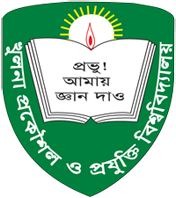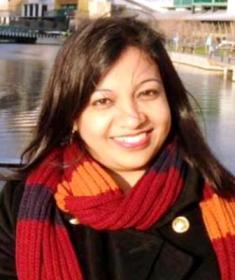Course Conduction
BME 1201 Biochemistry (Credit: 3.00) Introduction: The molecular logic of life, Biomacromolecules-compositions, and principles of organization, Energy, and principles of bioenergetics, Importance of biochemistry. Enzymes: Chemical nature, General properties, Spectro-photometric measurement of enzymes, Isolation techniques, Enzyme biotechnology, ELISA. Nucleic acids: Definition, Chemical composition and function, Nucleosides and nucleotides, DNA and RNA, Recombinant DNA and its applications. PCR. Carbohydrate: Classification, Structure, properties, and reactions of carbohydrates, Importance, Uses, Digestion, Absorption and Metabolism of carbohydrate, Glycolysis, oxidative phosphorylation, gluconeogenesis, TCA cycle, Function and regulation of TCA cycle. Glycosaminoglycan, Proteoglycans, and Glycoproteins. Protein: Structural unit, function, Classification, and properties of protein, Amino acids, Classification, properties and Titration curve of acetic acid, Amino acid, Alanine, Derivation of the equation, Henderson-Hasselbalch equation, Buffer, Peptide, various chemical reactions of protein, architecture, and Separation of protein molecules, Chromatography, Electrophoresis. Lipids: Classification and Metabolism of lipids, Cholesterol, Bile acids, Transport of lipid metabolism, Chemical nature of lipid types, Phospholipids, sphingolipids, Glycolipids: Definition, Types, Structure and oxidation of Fatty Acid, Ketone Body formation, degradation, Function, and disadvantage of Ketone body, Triacylglycerol Metabolism, Lipoprotein, and Steroid Metabolism. BME 1202 Biochemistry Laboratory (Credit: 0.75) Experiments based on BME 1215 Biochemistry. BME 2101 Human Anatomy (Credit: 3.00) Lower limb: Bones of lower limb; Front of the thigh; Medial side of thigh; Gluteal region; Popliteal fossa; Back of thigh; Front, lateral and medial side of a leg; Back of leg; sole of the foot; Joints of lower limb; Venous and lymphatic drainage; Arches of foot. Abdomen: Introduction to abdomen and osteology; Anterior abdominal wall; Male external genital organ; Abdominal cavity and peritoneum; Abdominal part of esophagus and stomach; Small and large intestine; Large blood vessel of gut; Extrahepatic biliary apparatus; Spleen, Pancrease, and liver; Kidney and ureter; Diaphragm; Posterior abdominal wall; Suprarenal gland and chromaffin system; Perineum; Urinary bladder and urethra; Boundary and contents of pelvis; Female reproductive system; Male reproductive organ; Rectum and anal canal; Wall of pelvis. Upper limb: Bones of the upper limb; Pectoral region; Axilla; Back; Cutaneous nerves, superficial veins, and lymphatic drainage; Scapularregion; Arm; Forearm and hand; Joints of the upper limb. Thorax: Bones and joints of thorax, the wall of thorax, thoracic cavity and pleurae; Lungs; Mediastinum; Pericardium and heart; Superior vena cava, aorta and pulmonary trunk; Trachea, oesophagus and thoracic duct. Head and neck: Osteology head and neck; Scalp, temple, and face; Side of neck; Back of neck; Contents of vertebral canal; Cranial cavity; Contents of orbit; Anterior triangle of neck; Parotid region; Temporal and infratemporal region; Submadibular region; Deep structure in neck; Prevertebral region; Mouth and pharynx; Nose and paranasal sinuses; Larynx; Ear; Eyeball. Brain: Introduction; Meaning of the brain and spinal cord; Spinal cord; Cranial nerves; Brainstem; Cerebellum; Fourth ventricle; Cerebrum; Third ventricle, lateral ventricle, and limbic system; Neural pathways and reticular formation; Blood supply of the brain and spinal cord. Histology: Histology of all human organs. Embryology: Introduction to embryology. BME 2201 Human Physiology (Credit: 3.00) Basic concepts of human physiology: Structure of the cell and cell membrane, Function of each component of the cell, Cell reproduction, Membrane potential, Action potential, Secondary messengers. Blood and immunity: Blood cells and their function, Blood clotting, Blood groups, Estimation of RBC, WBC and PLATELET, Immunity and immunodeficiency, Transplantation, Graft rejection and graft versus host reaction. Cardiovascular system: Properties of the heart muscle, Conductive system of heart, Cardiac cycle, Conduction of cardiac impulse, Electrocardiography, Standard leads of ECG, Regulation of heart rate, Regulation of blood pressure, Fetal circulation. Nervous system: Structure, Properties and function of a neuron, Synapses and synaptic transmission, Concept of sensory receptor and sense organ, Neurotransmitters and their classification, Neuromuscular junction, and nerve impulse transmission, Reflexes with their classification and reflex arc, Velocity of conduction of nerve impulse, Autonomic nervous system. Respiratory system: Pulmonary ventilation, Physical principles of gas exchanges, pulmonary volume and capacities, Transport of oxygen and carbon dioxide in the blood and tissue, Regulations of respiration, Pulmonary function tests. Digestive and excretory systems: Local hormone of GIT, Digestive enzymes, Mechanism of HCL secretion, Digestion and absorption of GIT, Mechanism of urine formation and acidification of urine, Renal function test, Skin and sweat gland, Secretion of exocrine and endocrine glands, Temperature regulation. Special senses: Optics of vision, Receptor and neural function of the retina, Photochemistry of vision, Central neurophysiology of vision, EOG, Mechanism of hearing, Hearing loss, Audiograms, Hearing tests, Taste and smell sensors. BME 2202 Human Physiology Laboratory (Credit: 1.50) Experiments based on BME 2217 Human Physiology. BME 3101 Cell Biology (Credit: 3.00) Introduction to Cell Biology: Basic concepts of cells, Animal cell vs Plant cell, Cellular respiration, Cellular transportation, Cell communication, Cell junctions, cell adhesion, and extracellular matrix. Cell division: Different Phages of Cell division, cell cycle control, Cell death; Apoptosis, Necrosis, Neoplasm. DNA, RNA, and the Flow of Genetic Information: Chemical composition and function of Nucleosides and nucleotides, DNA and RNA, Transcription and Translation, DNA repair and recombination, DNA sequencing, Control of gene expression and Stem cell. Immunology: Basic concepts of Immunity, Types of Immunity, Antigen, Antibody, and the Complement system. Immunological Disorder: Hypersensitivity, Transplantation, Graft rejection and graft versus host reaction. Common Methods related to Cell Biology and Immunology: Cell culture methods, Cell count under microscope Basic concepts of Western blot analysis technique, Flow cytometry, Cellular fluoroscopy technique, scanning electron microscope technique. BME 3103 Bioelectricity (Credit: 3.00) Electrical properties of cell: Overview on Semi-permeable membranes, membrane potentials, Nernst equation, electrical impulse pathways. Introduction to electrical fields, isocurrent, and isopotentials. Electrical properties of tissues: Conductivity, Dielectrics, polarization, relaxation, complex permittivity and conductivity, Cole-Cole model of tissue, Effect of external electric fields on biological tissues. Bioelectric modeling: Modeling volume conductor and volume source, forward and inverse problem. Solution of forward problem: Lead vector & image surface approach, Solution of inverse problem: Lead field theoretical approach, Reciprocal lead field, Sensitivity field, their application to ECG, EEG. Model of biological conductors: voltage-clamp & patch-clamp, core conductor model, cable model, Hodgkin-Huxley model of a neuron, Derivation of Hodgkin-Huxley (HH) model, Predictions from HH model, Application of bioelectricity in epilepsy; Parkinson’s disease; drug addiction diseases, Clinical applications of bioelectricity. Bioimpedance: Theory of measurement of Bio-impedance: electrodes, electrode- electrolyte interface, Electrical equivalent circuit of the electrode-skin interface, Bio- impedance measurement methods: two, three and four electrodes measurements, Focused Impedance Method (FIM), Pigeon Hole Imaging (PHI); Sensitivity field for bio-impedance: positive & negative sensitivity. complex impedance: Cole-Cole plot, Practical measurement of Bio-impedance: Basic electronic circuitry, Impedance Plethysmography & Impedance Tomography. Electrical Impedance Tomography (EIT), Clinical applications of Bio-impedance. Bioelectric stimulation: Applications in the biological tissue. BME 3142 X-ray and Ultrasound Imaging Laboratory (Credit: 1.50) Experiments based on BME 3141 X-ray and Ultrasound Imaging BME 4217 Rehabilitation Engineering (Credit: 3.00) Introduction to Rehabilitation: Definition; Epidemiology of Rehabilitation; Health; Levels of Prevention; Preventive Rehabilitation; Diagnosis of Disability; Functional Diagnosis; Importance of Physiatry in Functional diagnosis; Impairment disability handicap; Primary & secondary Disabilities;Effects of prolonged inactivity & Bed rest on the body system. Principles in management of communication: Impairment: Introduction to communication, Aphasia, Types of aphasia, Treatment of aphasic patient; Augmentative communication: general form of communication, types of visual aids, Hearing aids, Types of conventional hearing aid, Writing aids. Orthotic devices in rehabilitation engineering: General orthotics; Classification of orthotics: functional & regional; General principles of Orthosis; Biomechanics of orthoses; merits & demerits of orthotics; Material design consideration in orthotics; Calipers: FO, AFO, KAFO, HKAFO; Spinal Orthosis; Cervical; Head cervical thoracic orthosis; Thoraco lumbar-sacral orthosis; Lumbo Sacro orthosis; Splints: functions & types. Prosthetic devices: Introduction; Partial foot prostheses: Foot-ankle assembly;Transfemoral Prostheses: Knee unit, Axis system, Friction Mechanisms, Extension aid, Stabilizers, Socket; Disarticulation Prostheses: Knee Disarticulation Prostheses, Hip Disarticulation Prostheses. Mobility aids Walking frames; Parallel bars; Rollators; Quadripods; Tripods & walking sticks; Crutches; Wheelchairs. Supervision of Thesis of Postgraduate Students M.Sc. Engineering (BME) On Going Mostafizur Rahman M.Sc. Engineering (BME) On Going Mounita Gosh M.Sc. Engineering (BME) On Going Labonno Akter M.Sc. Engineering (BME) On Going Suhash Ranjan Halder M.Sc. Engineering (BME) On Going Zinnatun Nissa M.Sc. Engineering (BME) On Going Md. Zahid Hasan

